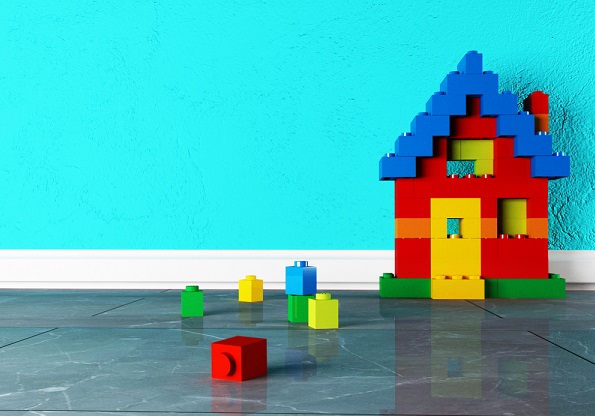Build a Content House to Capture Your Ideal Client’s Attention

By: Kasey Connors and Kelley Smith
You’ve already heard that creating content is an important part of your marketing strategy. When you’re ready to get started, it can be easy to jump into creating blogs and social media graphics. But it’s even easier to forget that creating content that attracts the right customers is what makes content marketing profitable.
To create content that effectively tells the story and value of your business to the right customers, you need a solid architecture. Think of it like a house. The roof of your content strategy is the value you bring to customers. What does your customer need or want that you can provide?
You can arrange your supporting content topics into content pillars for your strategy house. These pillars hold your roof up and support your value proposition. There is clear space between them, but they all support the same goal.
Here’s a tour of each section of the content strategy house and how you can develop each piece.
The Roof: Define Your Value to Your Customer
The most important part of any content strategy is a clear understanding of the value you provide to your ideal customers. To do this, look at your ideal customers to identify their needs and then define how you can help.
You can ask: Who are my ideal customers? What do they need? What do they want? How do my unique services provide what they need and want? The answers to these questions will be the roof to your content house and you may need to create different content houses depending on the customer.
One example that Trusted Choice® uses at the national level is established families. Our established families customer group looks like this:
Established Families
- Age: 30-55
- Household income: $100,000-$500,000
- Family status: Married with children
- Insurance need: To protect their assets and family, which are typically more complex than the average family household. This may include multiple cars and drivers, rental or second properties, and recreational vehicles.
- Value proposition: Trusted Choice independent insurance agents live and work in the communities they serve and offer a personal level of service for families as they navigate life’s changes.
- Desired customer perception: Trusted Choice independent insurance agents are on my side. They work to understand my individual needs and genuinely care about me and my family. They are trusted advisers throughout the many changes in my life.
You can also create audiences for businesses or more niche audiences. Consider the types of businesses that are in your local area, and see if you can identify where they need the most help. Are they expanding physical locations? Are they increasing their presence online? Do they have commercial vehicles?
For personal lines, ask if your ideal customers have recreational vehicles, are collectors or may benefit from an umbrella policy.
Once you have two to five ideal customers groups, define a clear value statement to summarize what they all have in common. This might look something like: Protect what is valuable to customers through a deep community connection.
Unclutter Your Message: Develop Content Pillars
With the value you aim to provide in mind, you can now create content pillars—the foundation of your content strategy house. Content pillars are three to five high-level topics that your agency should focus on when creating content. You can refer back to these pillars to make sure each piece of content you create fits into a pillar. This way, you know everything you share is relevant to your customers and supports your value.
To get started, take a look at all of your ideal customer groups and think about what types of content they’d like to see. Make sure these topics are broad but also related to your lines of business.
Let’s say you are an insurance agency on the North Carolina coast targeting established families. From your research, you know they are homeowners who like road trips. Your content pillars may be Life on the Open Road, Coastal Safety and Home Sweet Home.
Let’s walk through what types of insurance content can fit into these pillars:
Life on the Open Road: This category can accommodate any of your auto-related content, including car, motorcycle and recreational vehicles. This can include information for vacations or general driving on the coast and throughout North Carolina. This can include safety tips, common policy questions and how insurance varies based on the type of vehicle.
Coastal Safety: This category can include common safety tips and insurance needs related to living on the coast. This may include information about boating, hurricanes and floods. You can also consider the seasonality of weather-related risks and develop a series of content for before, during and after a storm that you can share throughout the year.
Home Sweet Home: This category can include anything related to home insurance. It can be general home or condo insurance tips or be specific to life on the coast. Consider that some people may also own vacation rental properties.
Notice how each content pillar is broad and can fit a variety of topics. However, they still stay true to the audiences’ interest and life stage as it relates to specific insurance business lines.
Still not sure where to start? One way to get inspiration is to look at other brands to see how other companies define their content pillars. Choose a brand you love from any industry and look at their website and social media accounts. See if you can guess what categories that brand focuses on. If you can see clear themes, it is likely that brand has well-defined content pillars.
Content pillars can also give you insight on what is performing well with your customers. One pillar may perform significantly better or worse than the others. Or maybe a subtheme stands out, like hurricanes in the coastal safety pillar. This way, you can create more content that your audience likes and replace content they don’t.
Use Your Content Strategy House to Define Your Content
Your content strategy house should define a clear direction and purpose for each piece of content you create. You can also use your audience demographics to decide what channels are best for you. Is your audience more active on Facebook, Instagram or LinkedIn? Do they prefer email? Do they like short-form video, articles or infographics? The age and consumption habits of your ideal customer may influence what types of content you create and where you post it.
If you still aren’t sure, test several types of content to see what works best. Let’s say you have a blog article that explains homeowners insurance, such as what it covers, claim examples and factors that influence cost. Use these sections to create infographics, videos and even talking points for you or your staff to explain on Instagram or Facebook stories. Sites like Canva provide templates and ideas to help you create graphics like a pro. This way, you can easily create a variety of content types to see what gets the most engagement.
Spending time with your team to develop content strategy can set the stage for creating content that resonates with your ideal audience and convinces them to buy. Plus, a clear vision can help keep your content focused throughout the year.
Kasey Connors is vice president of marketing operations, Trusted Choice. Kelley Smith is director of traffic generation, Trusted Choice.
Need more content ideas? Check out these Trusted Choice resources.
4 Ways to Define Your Ideal CustomerIt can be helpful to research what types of people in your community might fit into your ideal customer groups. This can help make your customer groups feel more real and personal. Remember, content posted online should answer common questions and concerns that your ideal customers have and should have the same tone as if you were speaking to them in person. The more you get to know your ideal customer, the easier content will be to create. Think about how so many digital experiences are tailored to specific users today. Amazon recommends products you may like, Facebook suggests businesses to try and travel sites recommend new locations to visit. All these companies can predict what their ideal customer might like because they know who they are. So, who do you want to invite to your content house? Here are four ways to collect customer information to bring your customer groups to life: 1) Identify trends. Consult your database to find out if customers live in common zip codes. Do they work for businesses of a certain size? Do they have children? 2) Create forms. Uncover information about your customers by using a form during the first meeting. Do they have recreational vehicles? Do they need insurance for collections, jewelry or other personal property? Do they run a small business or side hustle? 3) Harvest in-house expertise. Do any of your agents who speak to customers have insights? What are common questions? What do customers care most about? 4) Interview current customers. You will learn what is most important to them and how they spend their personal time. Also, this might help uncover common trends across people in your area.—KC & KS |










